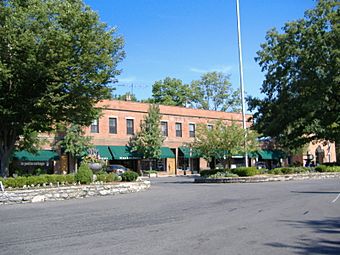Glendale Historic District (Glendale, Ohio) facts for kids
|
Glendale Historic District
|
|
 |
|
| Location | SR 747, Glendale, Ohio |
|---|---|
| Area | 392 acres (159 ha) |
| Built | 1861 |
| Architect | Multiple |
| Architectural style | Mid 19th Century Revival, Late Victorian and Late 19th and 20th Century Revivals |
| NRHP reference No. | 76001447 (original) 100003285 (increase) |
Quick facts for kids Significant dates |
|
| Added to NRHP | July 20, 1976 |
| Boundary increase | December 18, 2018 (also includes decreases) |
| Designated NHLD | May 5, 1977 |
The Glendale Historic District is a very special place in Glendale, Ohio. It's like stepping back in time! This area was carefully planned in 1851. It's one of the first neighborhoods ever designed for people to live in, away from a busy city. Its layout was inspired by the peaceful designs of old parks and cemeteries. The district has shady, winding streets and many old buildings that are still in great shape. Because it's so unique, it was named a National Historic Landmark in 1977.
Contents
Discovering Glendale's Historic Charm
The village of Glendale is located in southwestern Ohio. It's about 15 miles (24 km) north of the big city of Cincinnati. The historic part of Glendale covers about 392 acres (159 ha). It's generally bordered by Coral and Washington Avenues to the north. Springfield Pike (SR 4) is on the west side. Oak Street is to the south, and South Troy Avenue is on the east.
South Troy Avenue runs next to the railroad tracks. The main shopping area of the village is right near these tracks, close to Sharon Road. Congress Avenue is another important road. It goes north from where Springfield Pike and Oak Street meet.
What Makes Glendale Special?
The area east of Congress Avenue is mostly homes. It has winding roads and lots of old, tall trees. There are also two small parks in this area. Both parks are on East Fountain Avenue, which winds from southwest to northeast.
The houses in the district are mostly in styles called Italianate or Second Empire. These were popular building styles in the 1850s. They show how the village looked when it was first built. The old railroad depot in the district is now a museum. It has many items from Glendale's past. This includes stories from when John Hunt Morgan and his soldiers passed through during a famous event in the American Civil War.
A Look Back: How Glendale Started
Glendale was the idea of two Ohio businessmen, George Crawford and Henry Clark. They saw a great chance to build a new neighborhood. It would be along the railroad line of the Cincinnati, Hamilton and Dayton Railway. They bought about 600 acres (240 ha) of land for Glendale.
About 200 acres (81 ha) were designed by Robert Phillips, an engineer. Building started once the railroad began running in 1851.
Early Life in Glendale
At first, the village streets were lit by lamps that burned coal oil. By 1872, these were updated to natural gas lamps. It's amazing, but these old gas lamps are still used today! They add to the historic feel of the village.




